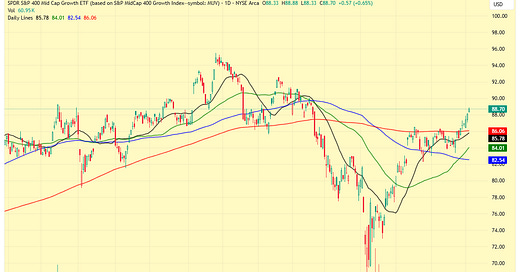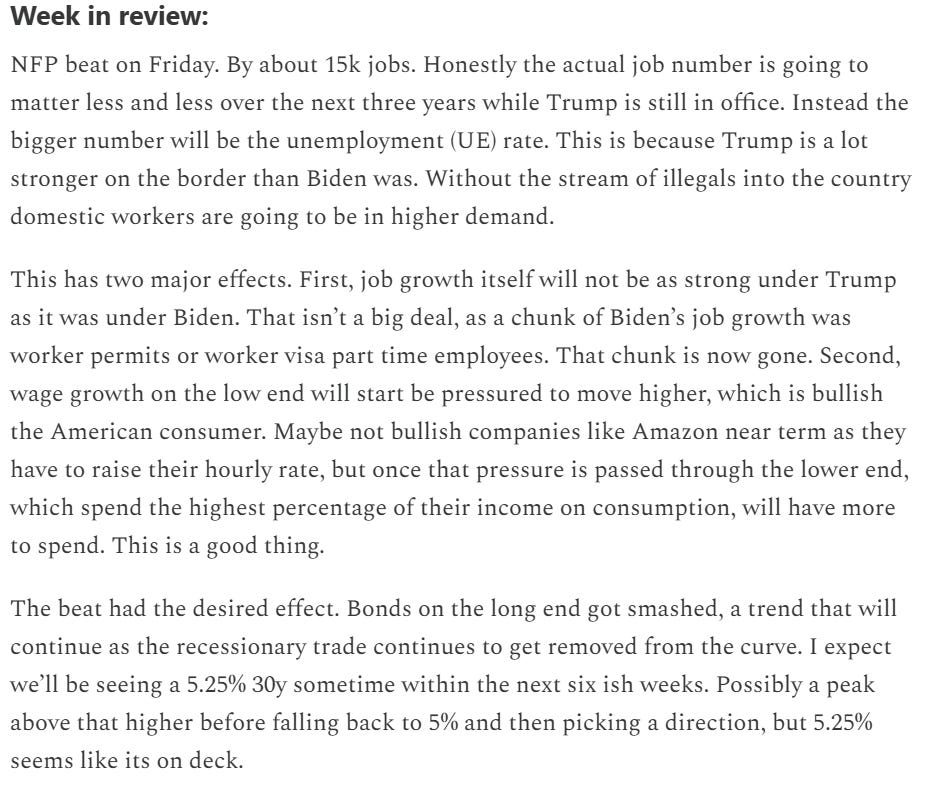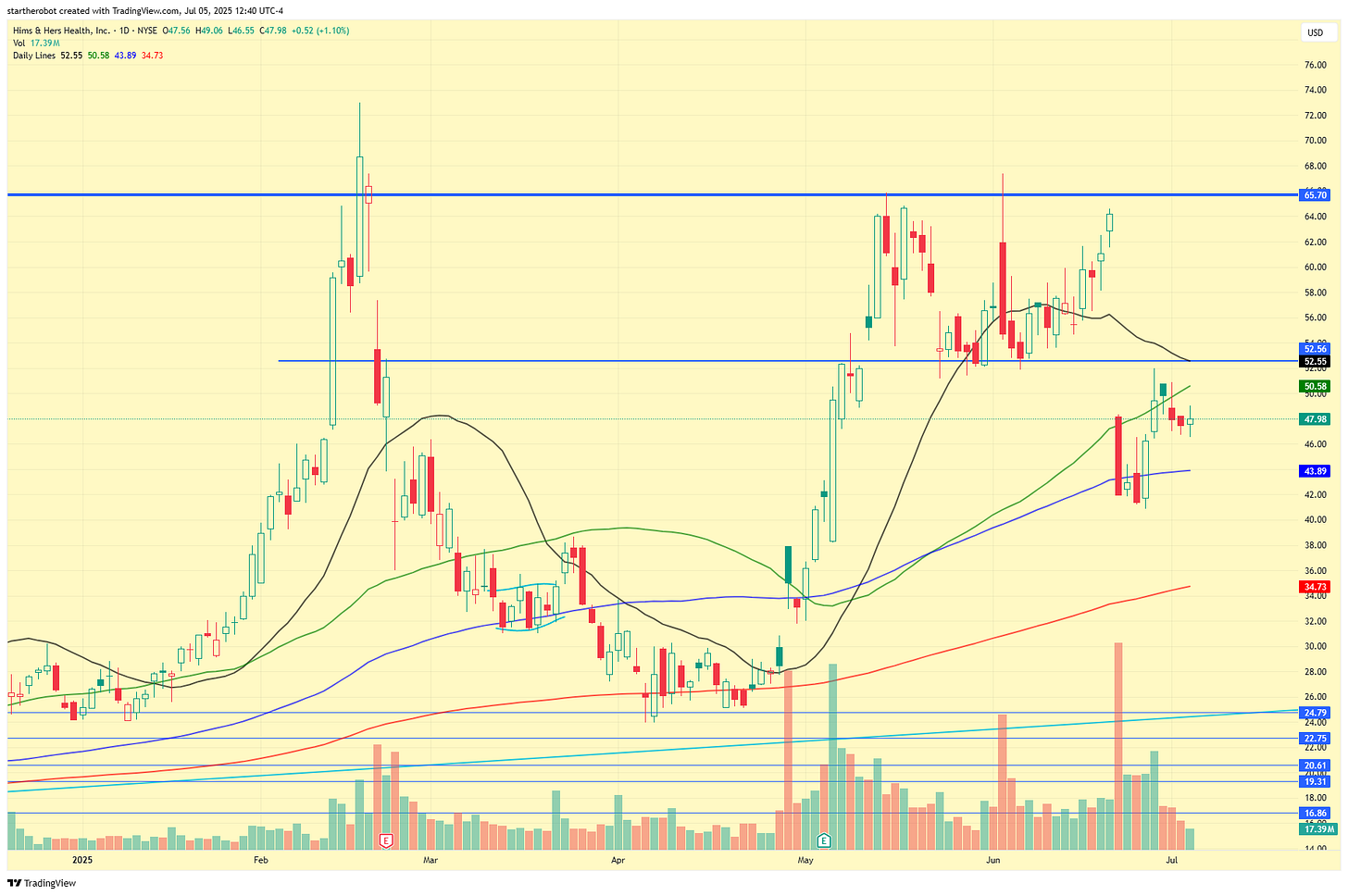With it end of the quarter on Monday and then repositioning on Tuesday there was a lot of noise in the tape that mostly amounted to a broadening out of the rally that started with just semi conductors last week. With notable movements in the midcap index as the leader. The S&P 400 hasn’t even made a new ATH yet.
This all led into the two big pieces of new on the week, the passage of the BBB and NFP.
We had another strong payroll number that the macro economists continue to try to explain away why everyone needs to be long bonds while their position continues to get blow on. What I wrote last month on NFP continues to be true and will continue well into early next year.
Macro economists are going to continue to point to the lower top line job creation number as clear signs of slowing growth and then yada yada yada it to the economy is rolling over and going to plunge into a recession. They’re wrong. Well not on the slowing job growth number, that is clearly there, but on the recessionary part of their broad point. See a decent chunk of the Biden era job growth was related to illegal or more fluid legal immigration. That has stalled out and with deportations increasing and border crossing decreasing there will less part time workers. They are getting replaced with already US based full time American workers. As I mentioned last month, this will lead to further pay increases on the low end as there isn’t a depressing effect of constantly having new worker come in to keep the clearly price for labor low.
This is going to get bad for industries that have been using those depressed labor costs to either keep their prices for customers down, or margins fat. Notably hospitality (specifically hotels) and senior living facilities. Both of these will likely see significant cost increases in the next three years.
Even bloomberg is starting to notice this.
This is all a long way of saying that the top line number matters less than the unemployment number. Its quite possible that the private sector only needs to see something like 60 - 80k job growth monthly based on domestic consumption increases. Anything above that might be extremely high. This excludes demands from immigrants and immigration broadly. If these numbers are accurate than it makes sense for the long end to sell off, as the private sector is cutting part time workers, hiring full time workers, and at a pace that indicates limited recession risk and healthy growth.
Can things get worse? yes. But it’s likely things will be better first, until wage inflation starts being injected into the system in a big way.
NFP was in the morning. In the afternoon was the passage of the big beautiful bill. I’ll have some deeper thoughts on it next week, but this again is pretty decent for the broad American based consumer. The no tax on tips and no tax on overtime basically don’t exist in any meaningful way, and the SALT increase is nice for people who aren’t smart enough or can’t leave blue states, but more importantly it locks in the TCJA from 2017 on a forward looking basis.
There’s a number of macro doomers (and political doomers because this is a political topic) that would like you to believe that this is going to blow out the budget and cause massive issues all over the system….and yes they’re right. When compared against the budget projections of the sunsetting of the TCJA of 2017 ending this year, the budget is going to get blown out more, but if you assume that no matter who won the white house in 2024 was going to try to lock in those tax cuts as they know there wouldn’t be a chance in hell of getting re-elected if everyone’s taxes went up somewhere between 10 - 23%, then the budget debt projections actually went down slightly.
This is mostly due to the immediate end of the EV, Solar, and other boondoggle tax credits that were passed in the IRA bill a few years ago, plus an increased tax on endowments. The end of these credits, mostly the EV credit is why Musk fought so hard against the BBB bill, not because of the debt ceiling, that was a red herring.
What is important to understand about the BBB is that it doesn’t really increase spending power by the consumers. In 2017 people’s taxes went down, they saw more of their paychecks. They then went out and spent more. This bill just locks in those cuts. There are little new tax cuts because the government is running out of things to cut. This means the net impact on consumption to the mid and high end consumers will be muted. As the SALT deduction increase is nice, but won’t move the needle much outside of people who live in NYC, Chicago, and all of California, New Jersey, and Massachusetts.
This limits the multiple expansion upside that was created in 2017 that Trump has been not so secretly hoping would get created that he will be able to take credit for. Back then we went from about 15/16x Forward (depending on the number you used) to 18/19 pretty quickly. Now sitting at around 21 NTM EPS, and a rosy EPS estimate picture at that, the multiple expansion upside should be muted nearer term. Especially with the upcoming tariff drama.
Both of these pieces of news will help buffer the economy though. Which won’t help Trump’s bloodthirst for lower rates. In fact a July rate cut should be off the table now, and the odd of September rate cut (roughly 75%~ as of writing this) should be at best 50/50.
The front running of this has already been a headwind for high multiple high beta (in theory high growth) names, which got destroyed on Tuesday and haven’t fully recovered. If there isn’t rate cuts coming soon, on the backs of a stronger economy, or at least one that is doing solid, then high beta will be weak. Some examples of this include stuff that’s absolutely exploded off the April bottom, from SMR no product nuclear names like OKLO and SMR, to Palantir, to Oscar and Hims, this isn’t sector specific, but factor specific. These are all names that if growth gets thin in the real world have the potential to out pace recession impulses, at least that’s the theory. All of them have been weak the last seven or so sessions and didn’t have fantastic Friday price action.
Even the ones that did go up on Friday, like Coreweave or Nebius, seem heavy. This is just a factor exposure I don’t think you want to own right now given that the real world might not be in as much trouble as the market thinks. Add in an appreciating dollar and this factor looks like it wants a bit of a break.
Here are some of the names I was talking about to give you an idea of what I’m seeing.
Even on the names that were green on Thursday volume was poor, even if you adjust for the missing three hours in the session.
That doesn’t mean its all bearish. I think there are two sectors worth considering here given the improving macro data for them.
The first is software.
Keep reading with a 7-day free trial
Subscribe to Sleepysol’s Newsletter to keep reading this post and get 7 days of free access to the full post archives.











